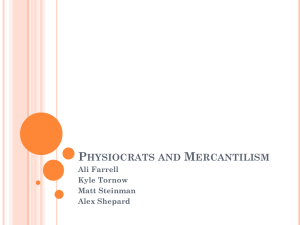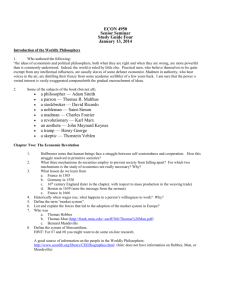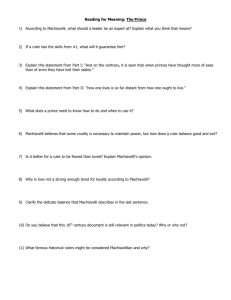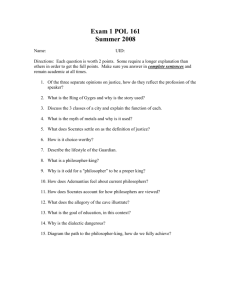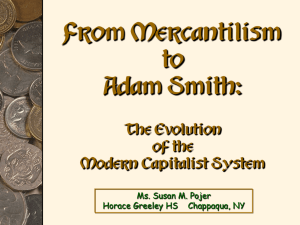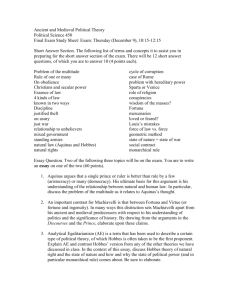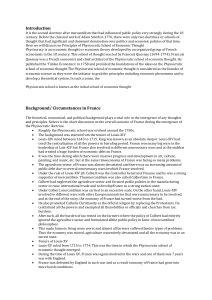K. Christ / History of Economic Thought Outline
advertisement
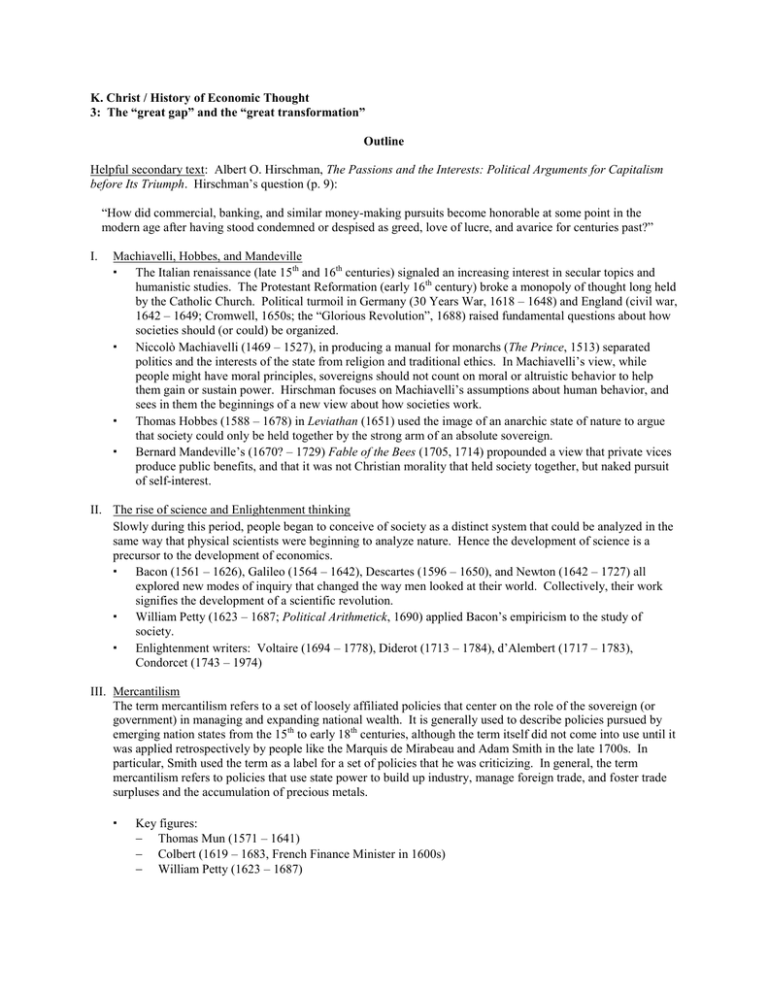
K. Christ / History of Economic Thought 3: The “great gap” and the “great transformation” Outline Helpful secondary text: Albert O. Hirschman, The Passions and the Interests: Political Arguments for Capitalism before Its Triumph. Hirschman’s question (p. 9): “How did commercial, banking, and similar money-making pursuits become honorable at some point in the modern age after having stood condemned or despised as greed, love of lucre, and avarice for centuries past?” I. Machiavelli, Hobbes, and Mandeville ∙ The Italian renaissance (late 15th and 16th centuries) signaled an increasing interest in secular topics and humanistic studies. The Protestant Reformation (early 16 th century) broke a monopoly of thought long held by the Catholic Church. Political turmoil in Germany (30 Years War, 1618 – 1648) and England (civil war, 1642 – 1649; Cromwell, 1650s; the “Glorious Revolution”, 1688) raised fundamental questions about how societies should (or could) be organized. ∙ Niccolò Machiavelli (1469 – 1527), in producing a manual for monarchs (The Prince, 1513) separated politics and the interests of the state from religion and traditional ethics. In Machiavelli’s view, while people might have moral principles, sovereigns should not count on moral or altruistic behavior to help them gain or sustain power. Hirschman focuses on Machiavelli’s assumptions about human behavior, and sees in them the beginnings of a new view about how societies work. ∙ Thomas Hobbes (1588 – 1678) in Leviathan (1651) used the image of an anarchic state of nature to argue that society could only be held together by the strong arm of an absolute sovereign. ∙ Bernard Mandeville’s (1670? – 1729) Fable of the Bees (1705, 1714) propounded a view that private vices produce public benefits, and that it was not Christian morality that held society together, but naked pursuit of self-interest. II. The rise of science and Enlightenment thinking Slowly during this period, people began to conceive of society as a distinct system that could be analyzed in the same way that physical scientists were beginning to analyze nature. Hence the development of science is a precursor to the development of economics. ∙ Bacon (1561 – 1626), Galileo (1564 – 1642), Descartes (1596 – 1650), and Newton (1642 – 1727) all explored new modes of inquiry that changed the way men looked at their world. Collectively, their work signifies the development of a scientific revolution. ∙ William Petty (1623 – 1687; Political Arithmetick, 1690) applied Bacon’s empiricism to the study of society. ∙ Enlightenment writers: Voltaire (1694 – 1778), Diderot (1713 – 1784), d’Alembert (1717 – 1783), Condorcet (1743 – 1974) III. Mercantilism The term mercantilism refers to a set of loosely affiliated policies that center on the role of the sovereign (or government) in managing and expanding national wealth. It is generally used to describe policies pursued by emerging nation states from the 15th to early 18th centuries, although the term itself did not come into use until it was applied retrospectively by people like the Marquis de Mirabeau and Adam Smith in the late 1700s. In particular, Smith used the term as a label for a set of policies that he was criticizing. In general, the term mercantilism refers to policies that use state power to build up industry, manage foreign trade, and foster trade surpluses and the accumulation of precious metals. ∙ Key figures: Thomas Mun (1571 – 1641) Colbert (1619 – 1683, French Finance Minister in 1600s) William Petty (1623 – 1687) ∙ Key principles of mercantilism (to the extent that any can be said to exist) Wealth leads to power; money (gold) = wealth Trade surpluses bring in money Government policies can promote trade (external policies in support of trade). Policies concerning wages and prices in support of trade – keep wages low in the export sector to keep exports competitive IV. The Physiocrats Many historians regard the Physiocrats, a small group of philosophers in pre-revolutionary France, as the first organized group of economists. They were led by François Quesnay (1694 – 1774) and the Marquis de Mirabeau (1715 – 1789). Quesnay’s Tableau économique, an illustrated diagram that explained the circulation of money and goods between sectors in an economy, is usually considered to be the first formal economic model. Adam Smith became familiar with the Physiocrats and their views while traveling in France from 1764 to 1766. Key elements of the Physiocratic system: • Conception of an economy as a multi-sector system populated by different classes of participants • Importance of agriculture as the only “surplus-generating” sector in the economy • A “circular flow” understanding of money and goods, with growth contingent upon surplus generated by the agricultural sector • Active policy prescriptions – the state should actively maintain markets and the circular flow of income, but should not interfere with agriculture, and should strive to keep taxes low. V. The Scottish enlightenment writers ∙ Key figures: Adam Ferguson (1723 - 1816), an historian who wrote that “the present age is perfecting what a former age began” Francis Hutcheson (1694 – 1746), professor of moral philosophy at Edinburgh; one of Adam Smith’s teachers. David Hume (1711 – 1776). ∙ The British Moralists and moral sentimentalism as a response to Hobbes and Mandeville. VI. Other “Economist” Precursors to Smith • Richard Cantillon (1680? – 1734), An Essay on the Nature of Commerce in General (1730? 1755) • Anne Robert Jacques Turgot (1727 – 1781), Reflections on the Formation and Distribution of Wealth (1766) • James Stuart (1713 – 1780), Inquiry into the Principles of Political Economy (1767)
